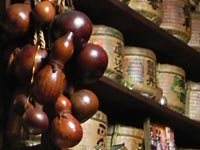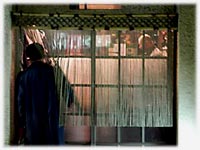- Yummy top
- Eateries and restaurants
- Uoyu - lunch restaurant
- Kanno
- Tokachiya
- Kitchen Nankai - Jinbocho
- Lamb Meat Tender
- Fujiyoshi - tempura restau.
- Enda - Japanese blue crab
- Fukuda - globefish pot
- Sugimoto
- Fuushi
- Soba restaurant
- Shinano - Akabanebashi
- Juwari-soba Inamuraya
- Ando and Korin
- Toranomon Sunaba
- Izakaya
- subLime and Kakinoki
- Donburi-bachi
- Renka
- Yoshida
- Daini-Chikarashuzo
- Sasagin
- Mugiya - soba izakaya
- Fukube
- Sasashin in Ningyo-cho
- Foreign cuisine
- Pizza Piazza
- Atelier de Fromage
- La Piccola Tavola
- Milieu - salad lunch
- Cafe Moskow - Spanish bar
- Sin Tong Kee
- Sekaihanten
- Miscellaneous
- Cheese & champignon party
- Natural Cheese Contest
- Donburi - rice bowl dish
- Home cooking
- Aji no nanban-zuke
- Spaghetti Carbonara
- Curry rice
Fukube - old fashioned izakaya next to the central station of Tokyo

Fukube is located in a vulgar side street of Yaesu district.
Fukube
Yaesu 1-4-5, Chuo-ku, 103-0028 TokyoTel: 03-3271-6065
Open 16:00-21:30 (Last order)

There are many gourd decorations in Fukube.
JR Tokyo Station faces two districts, Marunouchi and Yaesu, and two sets of gates accordingly.
"Marunouchi" means "within the outer moat" to protect the castle from invasion and residences of feudal lords existed there during the Edo period (1603-1867). After the Meiji Restoration (1868) residences were demolished and the area was converted into military facilities. It was then sold to Mitsubishi Concern and the first Western style street with brick buildings was constructed in 1894. Marunouchi has grown to be the center of Japanese capitalism where Mitsubishi and other major Japanese companies have their prestigious headquarters. Ambassadors accredited to Japan ride in a couch from Marunouchi Central Gate of JR Tokyo Station and head to the nearby Imperial Palace to present their credentials to the Emperor. Marunouchi is, thus, the front door to Tokyo.
"Yaesu" on the other hand comes from the name of a Dutch advisor of the first Shogun Tokugawa Ieyasu, Jan Joosten van Lodensteyn (c. 1560-1623). He lived in the present Marunouchi district on the west side of Tokyo Station and the area of his residence was called after his Japanese name "Yayosu" and later the pronunciation was slightly changed to be "Yaesu". When a bridge was built to connect Nihonbashi district over the outer moat with the Yaesu area in Marunouchi in 1884, it was named Yaesu Bridge. However, when Tokyo Station was constructed on the west bank of the moat in 1914, Yaesu Bridge was torn down and no gate was constructed to the moat side. After the Great Kanto Earthquake in 1923, a new Yaesu Bridge was built in 1925 and a new gate of Tokyo Station leading to the Yaesu Bridge opened in 1929 and was named after the Bridge.
After WWII the outer moat was reclaimed and the Bridge was finally torn down, however the name Yaesu did not lose its significance but expanded its scope. In 1949 the area adjacent to the Yaesu gate came to be called Yaesu district, while the original Yaesu area is not any more called as Yaesu. In short, Yaesu moved to the present place after WWII. Present Yaesu was originally an outskirt of the commercial districts of Nihonbashi. Therefore, while Marunouchi belongs to big capital, Yaesu is a town of common people and nearer to the everyday life. Yaesu is a kind of back door to Tokyo.
On the Yaesu side of Tokyo Station a commercial district developed since the opining of Yaesu gate, in other words, since the beginning of the Showa period (*) and numerous bars and izakayas belong it. Fukube opened in 1939 right in the middle of such area and well retains the atmosphere of traditional izakaya.
| (*) | "Showa period" is the time when Emperor Showa reigned over Japan: 1926-1989 |
 Izakaya "Fukube" is located in a vulgar side street of Yaesu.
Izakaya "Fukube" is located in a vulgar side street of Yaesu.
Fukube does not have an impressive facade but a couple of modestly illuminated signs and a wood and glass sliding door with rope curtain. Entering the door we can experience a sort of time trip into the Showa period.

Nearly all guests are middle and old aged businessmen.
 The main room, though very small, is equipped with a counter with 10 seats. Regular customers should be seated at the counter. But, it is not easy for a newcomer to enjoy a privilege to have a seat at the counter, in particular when we are in group. There is an annex room with several tables and whenever I am in Fukube I find there my place. Anyhow, traditional style interior with dark timber and mud wall is authentic traditional and comfortable, though thick cigarette smoke is often disturbing to non-smoker like me. A large majority of guests are middle and old aged businessmen and a few female guests also look old and heavy drinker.
The main room, though very small, is equipped with a counter with 10 seats. Regular customers should be seated at the counter. But, it is not easy for a newcomer to enjoy a privilege to have a seat at the counter, in particular when we are in group. There is an annex room with several tables and whenever I am in Fukube I find there my place. Anyhow, traditional style interior with dark timber and mud wall is authentic traditional and comfortable, though thick cigarette smoke is often disturbing to non-smoker like me. A large majority of guests are middle and old aged businessmen and a few female guests also look old and heavy drinker.
The abundance of selection of sake is a strong appeal to guests. Small casks of sake, covered with straw mat, are displayed on shelves attached to wall. I would dare to say that the selection is a bit old fashioned. In the world of sake there is a fashion and many names I see in Fukube are those which were popular in the past decades.


Nuta (Fish in sweet-sour miso dressing)
The way they serve sake is somewhat old-fashioned; they serve sake at room temperature. This style was once a standard in cheap or popular izakayas and this suggests that Fukube is loyal to the tradition. But, nowadays, maybe due to the influence from the European style of drinking white wine, it is fashionable to serve chilly cold sake. Hiya-zake (sake served at room temperature) and Reishu (sake served chilly cold) look similar when written in Chinese characters, but are essentially different. I personally prefer cold sake and think that I cannot say that I am a sake connoisseur.
Fukube has two dozen or so tidbits menus and they are old fashioned as well. I am interested in "kusaya" - fermented and dried fish - ,but does not have courage to order it, because it badly stinks, though it is a special delicacy. The photos I put up here are two very standard dishes: Atsuage and Nuta. Both are my favorites. When Japanese man gets old, his eating habit returns back to the very traditional taste. The taste of mom's cooking does not require any effort for congestion. The prices of tidbits range between 500 and 1000 yen. Together with sake, it is enough to pay at most 3,000 yen per person.
It is a miracle that we can experience the atmosphere of the 1960s in Tokyo in the neighborhood of the central railway station of Tokyo.